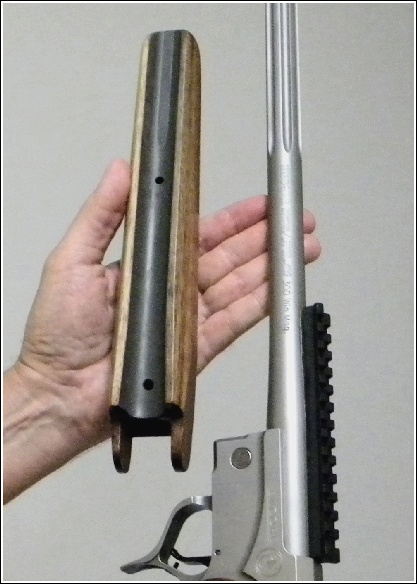This shows the original T/C Encore stock right out of the box.
Notice how poorly the top of the recoil pad was fitted by the factory. This T/C Encore rifle came with a nice looking walnut stock. However, the factory finish really hid the quality of the wood. This stock originally came with a 14.5" length of pull, and that's way too long for most shooters. This project shows the sequence steps required to make this rifle "fit" the average size shooter.
This shows how much the stock needs to be shortened to fit the shooter.
As you can see, the cheek piece will soon be quite a ways too far back. However, that can be fixed with the right tools. It's a good idea to use masking tape whenever you shorten a stock, because it shows up better than marking the stock itself, and it helps protect the finish from chipping at the edges. That won't be important consideration with this particular stock, because it will soon be refinished.
Yep . . . . this shortened stock really leaves the cheek piece too far back.
The cheek piece will need to be cut forward by about 1.5 inches. Otherwise, it would look like crap; and it might be positioned to jab the shooter in the neck.
Try to reuse the factory pad if possible.
This factory recoil pad was made from an extremely soft rubber that just melted and turned gummy when it was touched by a belt sander. It would have been a nice looking recoil pad if it was able to be reshaped to fit this stock. However, this inexpensive recoil pad was made in such a way that it defied any attempt refit it to this rifle. That's probably why the factory didn't try to make it fit a little better.
This is a Pachmayr Decelerator recoil pad - one of my favorites.
This is what a new recoil pad (right out of the box) looks like when it first gets attached to the stock. Every recoil pad needs to be sanded to the particular size of each rifle and should be fitted perfectly. During the mass production of some firearms, it isn't always done that way. If it was, most shooters wouldn't want to pay what it would cost.
This is a recoil pad jig for holding the pad at the angle when cutting it to size.
This jig is a valuable tool for fitting recoil pads. With the pad installed, you can then trace a line around the outline of the stock. Then you can see how much material to cut off with the belt (or disc) sander. I rub a small amount of white chalk into that scribed line. That makes it easier to see when you're cutting along the scribed outline.
The new recoil pad is now fitted.
I prefer this particular recoil pad over most others; because it reduces felt recoil as much as (or more than) any other pad I've ever tried, and it looks great. Remember the original cheek piece location? After shortening the stock by over an inch, the cheek piece now needs to be moved forward.
This black line shows how much of the cheek piece needs to be cut away.
Correct positioning of the cheek piece raises the shooters position to provide the best shooting position with ideal sight alignment. The cheek piece should also be positioned to have minimal or no contact with your ear muffs.
This looks much better. It took a whole lot of sanding to remove that much material.
Again, having the right tools makes this job a whole lot easier. This part of the project involves patience and a bit of determination.
I removed the factory finish without using chemicals.
The best way I've found to remove the old finish is by using a variety of scrapers and razor blades. Most people are suprised to see how quickly you can scrape a stock down to the bare wood. Remove the old finish from curved surfaces with small sanding drums (at low speed) using a Dremel tool. I remember my high school shop teacher (old three fingers) once told me how important it was to always sand a project to perfection before applying the final finish.
|
|
|
Other Improvements . . . .
Notice the poor wood to metal fit. It's an easy job to make this stock fit better. |
This looks much better. |
The grip is so thick that it actually makes the trigger hard to reach especially for smaller hands. |
It's far more ergonomic after a bit of reshaping. |
|
The shape of this grip looks very plain. It doesn't take much imagination to improve this. |
The wood now looks better, and the grip has a much more user friendly shape. |
"There's a lot of work involved, but the end result is a rifle that fits the shooter perfectly.
This improvement will help a shooter's confidence, and that really does make it shoot better.
Besides . . . . life is too short to hunt with an ugly rifle."



